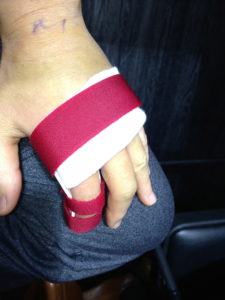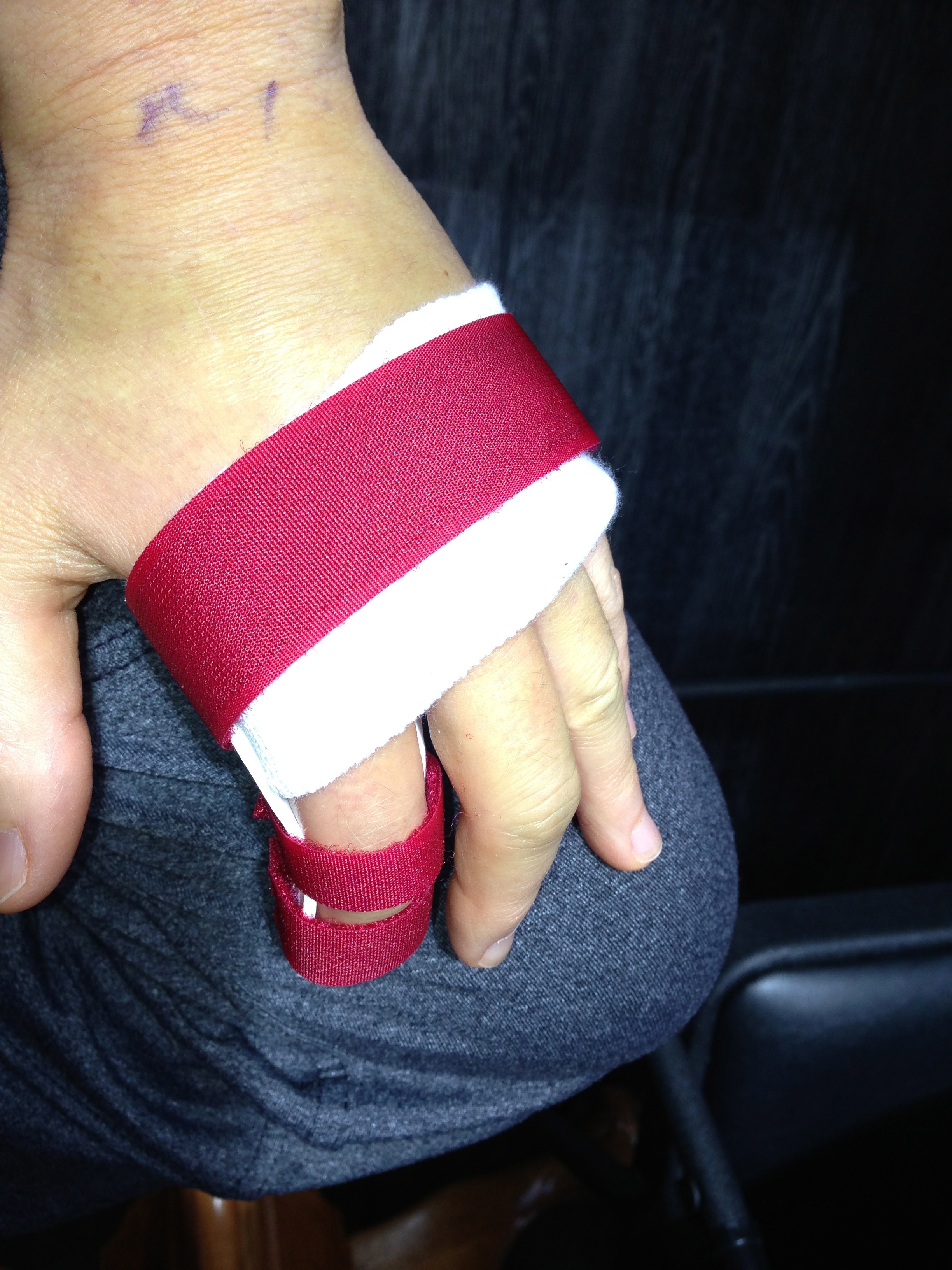Now for the fun part! I was absolutely thrilled to get the cast off my arm at my first occupational therapy (OT) appointment post-op on April 3, 2013. I don’t have a picture of the cast, since I wasn’t planning on documenting this whole process at the time. It felt fantastic when my hand therapist cut through the dressing with regular old scissors, my pinky and ring fingers could stretch out again. “Hmm... I could have done that myself,” I was thinking. Looking at my hand was very, very difficult. It was swollen up like a paw and various shades of purple, blue and black and the incision was particularly upsetting for me. I misunderstood the orientation of the incision, I thought it would be the long way from index finger to thumb. Instead, it goes across the knuckle into the middle finger knuckle, perpendicular to the fingers. It was only 7 sutures, and not nearly as long as I had guessed. My hand therapist made me a splint for night time that holds my finger at a 60 degree angle to let the muscles rest in a balanced way. I got to pick the color of the velcro strapping - red, or course! Then she told me that I only needed buddy wraps, black velcro strips to attach middle and first fingers together, for the day time. I was shocked... “That’s it? You do realize I have 2 little kids at home?”
 Then she gave me my exercises. My rehab consisted of 14 different exercises, all of which need to be repeated 10 times, with 4-5 sets of the whole thing per day. Wow... now the real work starts. The first exercise is forearm rotation. I teach this regularly as part of my Body Mapping course to musicians. This movement is an elbow movement and shouldn’t be a problem I thought. I quickly found out that I was wrong about this since all movements of my arm, wrist, hand, and fingers were compromised by the surgery and immobilization. Intellectually, I understood this. Practically, I was devastated that I had lost so much movement in such a short time. Before surgery, I had pretty much full use of my arm, wrist and hand. I learned to do things in weird ways to compensate for lack of pincer grasp. Complete and utter devastation. I felt like I was going to throw up while trying to do the exercises. Remember, how I said I stopped the Percocet? This was the wrong thing to do because the pain medication is absolutely necessary to get through the movements.
Then she gave me my exercises. My rehab consisted of 14 different exercises, all of which need to be repeated 10 times, with 4-5 sets of the whole thing per day. Wow... now the real work starts. The first exercise is forearm rotation. I teach this regularly as part of my Body Mapping course to musicians. This movement is an elbow movement and shouldn’t be a problem I thought. I quickly found out that I was wrong about this since all movements of my arm, wrist, hand, and fingers were compromised by the surgery and immobilization. Intellectually, I understood this. Practically, I was devastated that I had lost so much movement in such a short time. Before surgery, I had pretty much full use of my arm, wrist and hand. I learned to do things in weird ways to compensate for lack of pincer grasp. Complete and utter devastation. I felt like I was going to throw up while trying to do the exercises. Remember, how I said I stopped the Percocet? This was the wrong thing to do because the pain medication is absolutely necessary to get through the movements.
 My doctor gave me a prescription for Tylenol with codeine, as it was stronger than the plain Tylenol and not as strong as the Percocet. It literally felt like my hand was ripping apart inside. My therapist said there was nothing I could do to damage it as long as I moved my index finger only with it’s own muscles, with no moving it with my right hand. Many questions were asked so that I was crystal clear about how to find the line between appropriate effort and “too much.” My plan was and is to go right to the line every time.
My doctor gave me a prescription for Tylenol with codeine, as it was stronger than the plain Tylenol and not as strong as the Percocet. It literally felt like my hand was ripping apart inside. My therapist said there was nothing I could do to damage it as long as I moved my index finger only with it’s own muscles, with no moving it with my right hand. Many questions were asked so that I was crystal clear about how to find the line between appropriate effort and “too much.” My plan was and is to go right to the line every time.
Trying to do my first set of exercises at home was one of the most frustrating experiences of my life to date. Sending the signal to my fingers to move and having absolutely nothing happen was terrible. Then I started to get angry. I kept at it though with beads of sweat appearing on my forehead and gulping glasses of water. How can this be so much freaking work when nothing is happening? In my head, I was hearing Jim Valvano’s voice, “Don’t give up, don’t ever give up” from his ESPY award speech. This is the clip shown often with the Jimmy V Classic basketball tournament to raise money for cancer research. I was utterly exhausted and didn’t do any more sets that day. I figured the exercises at the office counted, plus my prescription wasn’t filled until later that day. That’s the only time I’ve skipped exercises.
I decided that I needed to work smarter, not harder during the exercises by applying what I’ve learned about how bodies are designed to work through my Andover Educator training, as well as information I’ve learned through Alexander Technique and Feldenkrais. My mantra has become “I will not be denied.” I will get this done and get back to flying.
My Steps to Working Smarter
Step 1: The first thing was to find out exactly which muscle(s) should be working for each exercise, as well as which muscle(s) should not be trying to help. Muscles are usually found in pairs, when one contracts, the other releases into length. I used the Visible Body Muscles 3D app on my iPad as well as Trail Guide to the Body by Andrew Biel and Anatomy of Movement by Blandine Germain-Calais. I went through each exercise and wrote on instruction sheet the name of the muscle, its origin and insertion points. A ha.... there’s a reason that wrist adduction/abduction was difficult. Flexor carpi radialis attaches to the base of the index finger! And so on... the revelations just kept coming. I’ve studied hands and arms a lot, but I guess I never needed to know with this much accuracy and detail. Body maps can be continually refined and knowledge is power.
Step 2: When doing the exercises, I looked at the page in the Trail Guide that shows synergists... all the muscles that work together to execute a movement. Visually, I was able to direct my focus to where the muscle in question was supposed to be moving. Even if there is no movement at the finger tip, the muscle can still be working.
Step 3: I reminded myself continually that these exercises are whole body movements, not just finger or hand movements, and that I always needed to keep the part within the context of the whole. I forced myself to have feet on the floor, butt firmly in the seat balanced on rocker bone, leading movement with my head. I didn’t allow myself to hold my breath.
Step 4: Accepting the nasty, swollen, stitched, discolored, gross, disfigured finger/hand as part of my whole body was absolutely essential. Again, it was a return to emphasis of the part within the context of the whole. It wasn’t my finger’s fault that it’s been through trauma and it’s no happier about the situation than the rest of me.
Step 5: Once I was able to remove all pieces/parts of my dressing, I was able to do much better with the exercises. Just being able to visually see the joints and the movement (or lack thereof) was tremendously helpful. The pain meds blocked the pain, but also blocked kinesthetic awareness, at least for me.
Step 6: I started doing the exercises with both hands, mirroring each other. I remember one of my teachers telling me to use the good side to teach the bad side. It is amazing how much my gimpy left hand movement in general, as well as fluidity of said movement improves with the help from right hand.
Step 7: One day, it occurred to me that I’ve spent many hours of my life in gyms.... Medina Rec. Center, OSU weight room, Baldwin-Wallace weight room, various garages of homes I’ve lived in and the living rooms of my various apartment and I’ve never worked out without loud, pounding rock music. I cranked some up vintage Van Halen on the trusty iPod and got to work. Sounds stupid, but it helped and I was open for every bit of help from anywhere.
Step 8: I borrowed from my weight training experience again - you should exhale on the hardest part of the movement and inhale on the easy part. So for a bench press, inhale when the bar is moving towards your chest and exhale when you’re pushing the bar back up. For me, this translates to exhaling when trying to bring my index finger back up straight to full extension. Right now, it feels like my whole hand is ripping apart inside when do this, 14 exercises x 10 reps x 4 sets = 560 times per day. Reminding myself to channel my inner Adrian Peterson - fight, grind, work. See previous post for more about this guy.
Step 9: Warning -- geeky music statement coming up. I figured out that I can keep track of what I’m doing when I count in triple meter. I’m supposed to hold each movement for 5, so here’s what I’m thinking “1-2-3 4-5-6, Up-2-3- 4-5-down; 2-2-3 4-5-6, Up-2-3- 4-5-down etc. The movement happen on 6. Sometimes this is a mental challenge to do with the music cranking out of the stereo. Counting out loud helps. Keeping a steady pulse helps. Counting the repetitions the same way musicians count rests helps (1-2-3-4, 2-2-3-4, 3-2-3-4, et.).
For this whole first week, my exercises were taking around 1 hour and 15 minutes per set, including ice time. My schedule was to take the pain med, wait 45 minutes, then start. Rinse and repeat. Yes, do the math and it was taking 5 hours per day. But there was no short cut.
I was exhausted. There was not much energy left over for anything else when it’s all going into healing a certain area. My first acupuncture treatment at 8 days post-op was fantastic. The amount of pain relief was amazing. I also had a chiropractor appointment on the same day and head, elbow and SI joints were now happily aligned. My father is a Reiki practitioner and I had that too. As I said, I was happy to take any help offered. These three events happened on a Friday and on the following Saturday morning, it was like having a new hand! The swelling was down so much overnight. Simply incredible how much more movement there is when the swelling isn’t around to interfere.
There was and continues to be a brain fog that goes along with the narcotic use. For example, my husband asked where my expenses were for the taxes, since he only had the income. My reply, “Uhhh... what? Huh????” Any other day, I would have known exactly where the computer file was that contained this information. The constant disorientation was and still is reminiscent of the mental state of mothers nursing newborns every two hours and wondering if they’ll ever sleep for more than twenty minutes at a time. Driving isn’t allowed while on the narcotics either. At this point, it was a non-issue since both of our cars are manual transmission and I couldn’t grip the steering wheel with my left hand, yet. Another instance of having my wings clipped, I haven’t had to depend on another driver since I got my driver’s license.
I had some new goals for OT: 1) learn to tie my own shoes so I can go running once the throbbing subsides, 2) learn to floss my teeth without having to use those stupid plastic flossers, and 3) safely shave my right arm pit. Interesting revisions since, when asked by my therapist what my goal was, I said “to return to full time flute playing without limitation.” No question about that being the long-term goal, but there are many other things that must be accomplished before that’s even in the realm of possibility.
Wednesday, April 10, 2013, rolled around and it was time for OT#2 with my hand therapist. She asked “How are you doing?” My reply, “I feel better, but I don’t know if I’m making the kind of progress that’s expected since I have no point of reference.” To make a long story short, I hit it out of the park! She said, “You’re a hand therapy rock star!” All 3 therapists and surgeon were thrilled with my progress. Apparently, at 13 days, I had the range of motion of somebody 4 weeks out. Too bad, I didn’t have the reduction in pain that goes along with that. Every other suture was taken out, because the incision area is under constant stress with the movements. The thread wasn’t cotton, it’s a plastic synthetic black thing and itched like crazy. Definitely more movement and less pulling with half of them out and I can’t wait for them all to be history. Interesting fact I learned: the therapists can tell which doctor put the sutures in by looking. Apparently each has his or her own signature stitch. Who knew?
Key things I learned during this stage of my journey:
1) The value of working smarter, not harder. See previous list.
2) I developed a healthy respect, admiration, and wonder for this thing called a hand. What a fascinating and marvelous design!
3) My fantastic results this week didn’t happen by accident. It was a team effort involving a good surgeon, acupuncturist/naturopath doctor, chiropractor, Reiki practitioner, appropriate extra vitamin supplements, support at home, and maximum attention and effort by me to complete the exercises assigned by my hand therapist.
4) It’s humbling to teach a child to open a child-proof medicine bottle since you need the pain med, you can’t open the bottle yourself, and you’re the only adult home at the time.

